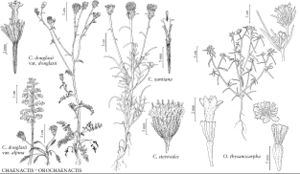Chaenactis douglasii var. douglasii
Biennials or perennials, (3–) 8–50 (–60) cm (sometimes slightly woody or flowering first-year, not or scarcely cespitose, not matted). Stems usually 1–5 (–12). Leaves basal (sometimes withering) and ± cauline, 1.5–12 (–15) cm, indument ± persistent. Heads (1–) 2–25+ per stem. Phyllaries: longest 9–15 (–17) mm; outer ± stipitate-glandular and, often, arachnoid to lanuginose and, sometimes, sparsely villous. 2n = 12, 24, 36 (plus dysploid numbers and triploids).
Phenology: Flowering May–Sep.
Habitat: Open sandy, gravelly, or rocky substrates in shrublands, woodlands, forests, often unstable or recently disturbed sites
Elevation: 400–3500 m
Distribution

Alta., B.C., Ariz., Calif., Colo., Idaho, Mont., Nev., N.Mex., N.Dak., Oreg., S.Dak., Utah, Wash., Wyo.
Discussion
Variety douglasii is known in and east of the Sierra Nevada and Cascade Ranges, to the western edge of the northern Great Plains, and in the Klamath Ranges and North Coast Ranges of northwestern California (where its lowest elevations occur). It is known from most mountains within that range; northward it also descends to the higher plains and valley floors. A report of var. douglasii from Saskatchewan was not verified by me. Seeds of var. douglasii are commercially available and are planted for revegetation or horticultural purposes and it may be found outside its native range.
Four ploidy levels were documented across the range of var. douglasii by J. S. Mooring (1965, 1980) and P. H. Raven and D. W. Kyhos (1961). Mooring’s (1980) data suggested that diploids are more frequent at higher elevations in major mountain chains and are more often mixed with polyploids at lower elevations or in areas of Pleistocene or later disturbance. The chromosome numbers listed above are predominant; Mooring (1965, 1980, 1992) also documented 2n = 14, 15, 26, or 30 as regular bivalents. Additional numbers, involving various combinations of bivalents with univalents, tetravalents, and/or extra chromosomes, have been observed.
Most of the diploid elements of var. douglasii are distinctive and are connected by a morphologically continuous series of polyploids (usually assigned to var. achilleifolia). Some diploid forms (including var. rubricaulis and Chaenactis ramosa) appear repeatedly and discontinuously in suitable habitats. In particular, forms named var. montana seem to arise wherever the species reaches sufficient elevation. Such populations have no historic or genetic cohesion to justify their recognition as a collective taxon, even though their reduced stature may become genetically fixed in each instance. (Variety alpina, recognized below with hesitation, may be just an extreme such case.) Chaenactis angustifolia of the northern Rocky Mountains and possibly C. pedicularia of Colorado are more distinctive morphologically and geographically, and merit further study and possible varietal status.
Selected References
Lower Taxa
"longest" is not a number.
